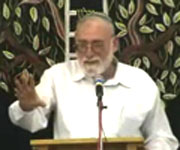Beit Midrash
- Torah Portion and Tanach
- Vayikra
- Achrei Mot
The Parsha describes the 'seder avodah' --the entire service that takes place on Yom Kippur in the Beit Hamikdash. However, before the Torah begins its description it mentions- "after the death of the two sons of Aaron, when they drew near before the L-rd, and died". Why is it necessary to mention this? The next pasuk explains: "Speak unto Aaron thy brother, that he come not at all times into the holy place within the veil…that he not die".
In other words, if you'd like to enter into the Kodesh Hakodashim (Holy of Holies), there are a few absolute conditions: You must bring sacrifices, wear specific clothing, and only enter on the day of Yom Kippur. The Torah tells you how, when, and where you may approach.
So why begin the description of the Avoda with telling us of the demise of the sons of Aaron?
It seems that after the death of the two sons of Aaron, Nadav and Avihu, one could assume that from now on, there is no longer an opportunity for entering this most holy place. Who would want to take such a risk? Wouldn't it be wise to avoid "playing with fire"? Better to keep away. "Look at what happened to Nadav and Avihu!". The motivation and desire to come close to Hashem is much reduced or even gone.
However, here comes the Torah with a new interpretation: G-d wants us to come close to Him. It is proper and legitimate to come into the Kodesh Hakodashim. Nadav and Avihu's actions are correct in principle, although, in practice there are ways of doing things. Conditions and constraints are required- the how, why, and where. These rules are not here just for their own sake, but rather, these restrictions are what allow us to approach Hashem.
How amazing it is to see the commentary of the Vilna Gaon (Vayikra 16:5) and the Netziv (Vayikra 16:2,32) that explain why the Torah only mentions the calendar date of Yom Kippur (10th of Tishrei) at the end of the long description of the Avodah. They explain that truly Aaron had the privilege and right to enter the Kodesh Hakodashim all year round. If he wanted, all he needed to do to enter was to fulfill the entire Avodah and procedures of Yom Kippur on any single day. In this way, he was able to "come at all times into the Holy Place".
The Parsha teaches us the true purpose of the Avodah on Yom Kippur, namely, the fixing of the sin of Nadav and Avihu. The laws of the Torah are not meant to limit us. Rather, it is to enable us to have the closeness and relationship we desire between G-d and ourselves.























